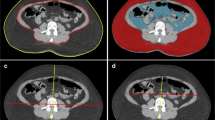Abstract
Introduction
After adopting preoperative assessment of the perigastric vessels using 3D-CT and standardization of the procedures, obesity still influences smooth laparoscopy assisted gastrectomy (LAG). We evaluated the impact of body mass index (BMI) and area of visceral fat tissue on the risks of LAG.
Methods
Sixty-six patients who underwent LAG for gastric cancer were included. The patients were divided into two groups by BMI (<25 BMI-L group: n = 53; ≥25 BMI-H group: n = 13) and area of intraperitoneal fat tissue (<100 cm2 AF-L group: n = 35; ≥100 cm2 AF-H group: n = 31), respectively. Fat scan®, which was computer software operating on abdominal CT, was used to measure the visceral fat areas (VFA). The incidence of postoperative complications, operation time, intraoperative blood loss, and number of dissected lymph nodes were compared between each two groups.
Results
The incidence of postoperative complications of BMI-L and BMI-H groups was 11.3% and 30%, respectively (p = 0.18). The mean blood loss was 85 and 134 g, respectively (p = 0.21). There were no significant differences in operation time and the number of retrieved LNs. The incidence postoperative complications (29%) and mean blood loss (148 g) of then VFA-H group were significantly higher than those of the VFA-L group (5.7%, 48 g). The number of retrieved LNs of the VFA-H group (n = 25) was significantly lower than that of the VFA-L group (n = 34). There was no significant difference in operation time.
Conclusions
In the VFA-H group, the incidence of postoperative complications and intraoperative blood loss increased, and the dissected number of LNs decreased. The area of visceral fat tissue was useful to predict risks of LAG and postoperative complications with higher precision compared with BMI.



Similar content being viewed by others
References
Noshiro H, Shimizu S, Nagai E, Ohuchida K, Tanaka M (2003) Laparoscopy-assisted distal gastrectomy for early gastric cancer. Ann Aurg 238:680–685
Tanaka K, Miyashiro I, Yano M, Kishi K, Motoori M, Seki Y, Noura S, Ohue M, Yamada T, Ohigashi H, Ishikawa O (2009) Accumulation of excess visceral fat is a risk factor for pancreatic fistula formation after total gastrectomy. Ann Surg Oncol 16:1520–1525
Lee JH, Paik YH, Lee JS, Kim CG, Park SR, Kim YW, Kook MC, Nam B, Bae JM (2007) Abdominal shape of gastric cancer patients influences short-term surgical outcomes. Ann Surg Oncol 14(4):1288–1294
Tokunaga M, Hiki N, Fukunaga T, Ohyama S, Yamaguchi T, Nakajima T (2009) Effect of individual fat areas on early surgical outcomes after open gastrectomy for gastric cancer. Br J Surg 96:496–500
Kunisaki C, Makino H, Takagawa R, Sato K, Kawamata M, Kanazawa A, Yamamoto N, Nagano Y, Fujii S, Shimada H (2009) Predictive factors for surgical complications of laparoscopy-assisted distal gastrectomy for gastric cancer. Surg Endosc 23:2085–2093
Lee HJ, Kim HH, Kim MC, Ryu SY, Kim W, Hyung WJ, Ryu SW (2009) The impact of a high body mass index on laparoscopy assisted gastrectomy for gastric cancer. Surg Endosc 23:2473–2479
Yamada H, Kojima K, Inokuchi M, Kawano T, Sugihara K (2008) Effect of obesity on technical feasibility and postoperative outcomes of laparoscopy-assisted distal gastrectomy. Comparison with open distal gastrectomy. J Gastrointest Surg 12:997–1004
Makino H, Kunisaki C, Akiyama H, Ono H, Kosaka T, Takagawa R, Nagano Y, Shimada H (2008) Effect of obesity on intraoperative bleeding volume in open gastrectomy with D2 lymph-node dissection for gastric cancer. Patient Saf Surg 2:7
Kim K, Kim M, Jung G, Kim H (2006) The impact of obesity on LADG for early gastric cancer. Gastric Cancer 9:303–307
Hiki N, Fukunaga T, Yamaguchi T, Ogura T, Miyata S, Tokunaga M, Ohyama S, Sano T (2009) Increased fat content and body shape have little effect on the accuracy of lymph node retrieval and blood loss in laparoscopic distal gastrectomy for gastric cancer. J Gastrointest Surg 13:626–633
Yasuda K, Inomata M, Shiraishi N, Kitano S (2004) Laparoscopy-assisted distal gastrectomy for early gastric cancer in obese and nonobese patients. Surg Endosc 18:1253–1256
Tokunaga M, Hiki N, Fukunaga T, Yamaguchi T, Ogura T, Miyata S, Tokunaga M, Ohyama S, Sano T (2009) Better 5-year survival rate following curative gastrectomy in overweight patients. Ann Surg Oncol 16:3245–3251
Disclosures
Dr. Yoshikawa, Dr. Shimada, Dr. Kurita, Dr. Iwata, Dr. Nishioka, Dr. Morimoto, Dr. Miyatani, Dr. Komatsu, Dr. Mikami, Dr. Kashihara have no conflict of interest or financial ties to disclose.
Author information
Authors and Affiliations
Corresponding author
Rights and permissions
About this article
Cite this article
Yoshikawa, K., Shimada, M., Kurita, N. et al. Visceral fat area is superior to body mass index as a predictive factor for risk with laparoscopy-assisted gastrectomy for gastric cancer. Surg Endosc 25, 3825–3830 (2011). https://doi.org/10.1007/s00464-011-1798-7
Received:
Accepted:
Published:
Issue Date:
DOI: https://doi.org/10.1007/s00464-011-1798-7




